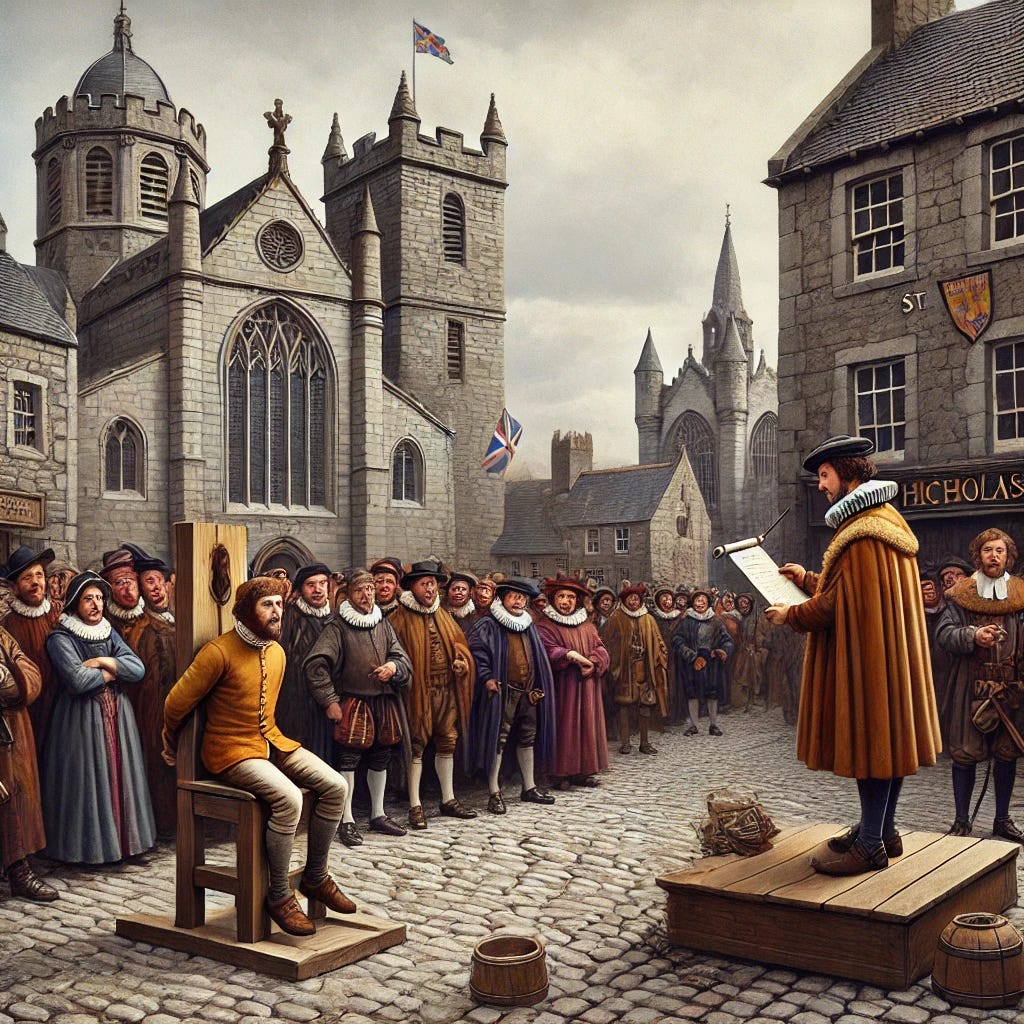In the 15th century, Aberdeen wasn’t just a trading hub or a bastion of civic pride — it was also a self-governing legal entity. As a royal burgh, Aberdeen had its own courts, its own procedures, and a surprising amount of legal independence. Trials were held regularly, crimes were catalogued in detail, and the town council kept meticulous records of both serious felonies and petty misdemeanours.
Legal proceedings were largely public affairs, carried out in the burgh court. Citizens were expected to participate — not just as defendants or plaintiffs, but often as jurors, assize members, or witnesses. The court operated under a system of customary law mixed with royal directives and charters.
Most criminal cases were judged by an assize, a jury of fellow citizens — typically between 5 to 20 individuals, depending on the seriousness of the crime. It was justice by your peers — though “peer” often just meant fellow townsman, not social equal.
What made Aberdeen's justice system stand out wasn’t just its structure — it was the wide range of strange, symbolic, and sometimes theatrical punishments handed out by the court.
Crimes of Everyday Life: What Got You in Trouble
You didn’t have to commit murder to end up in front of the town council. The spectrum of criminal charges ranged from life-and-death matters to the oddly specific:
Slaughter in a broil: Common enough that negotiated compositions (monetary compensation) were expected.
Forestalling and regrating: The act of buying goods before they reached market or reselling at higher prices. This was deeply offensive to medieval burgh morality.
Blasphemy and swearing: Repeated profanity could land you in real legal trouble.
Buying “lordship”: Citizens who sought feudal protection from a noble rather than the king or town were fined or stripped of rights.
Illegally wearing weapons: Citizens were to walk about armed only under certain circumstances; flaunting swords or knives could cause panic and draw censure.
Wife-beating or public disorder: Domestic violence and drunken fights were public matters, and repeat offenders were often made examples of.
Even things like quarrelling in church, interrupting processions, or unauthorised pageantry could bring the heavy hand of the law down.
Justice Served: From Stocks to Spectacle
While some crimes were met with fines or public apology, others had more dramatic consequences. The punishment often fit not just the crime, but the status of the offender. Some notable medieval punishments included:
1. Pillory and Stocks
The most recognizable medieval punishment, pillorying was used for everything from fraud to slander. Offenders were publicly displayed, sometimes with signs explaining their crimes. Rotten vegetables optional but likely.
2. Processions of Shame
Aberdeen loved a good spectacle. Offenders — particularly those convicted of sexual misconduct or blasphemy — might be paraded through the town, barefoot, in their underclothes, or with symbolic props. One famous case involved a woman made to carry a dead fish on her head for selling rotten salmon.
3. Banishment
For more serious offenses, especially repeat crimes or acts against the town’s safety, banishment was a preferred tool. Offenders were literally walked out of the gates and forbidden to return under pain of death or mutilation.
4. Mutilation
While not common, ear-cropping, branding, or cutting off a hand were not unheard of for repeat thieves or violent assailants. The town generally reserved this for non-burgesses or dangerous strangers.
5. Execution
Rare, but very real. Capital punishment was primarily for murder, arson, or treasonous acts. Hangings would usually take place outside the town walls, possibly on Gallow Hill. The corpse might be left on display as a warning to others.
Guilds, Crafts, and Internal Discipline
Each trade guild in Aberdeen had its own rules and internal codes of justice. Offenses like:
Selling shoddy goods
Cheating customers
Fighting with fellow tradesmen
...were not only punishable by the town council but also by the guild deacons.
Some penalties were financial, others ceremonial. If a shoemaker sold poorly sewn boots, he might be forced to wear them himself — inside out. Dyers (litsters) who used inferior ingredients might be shamed by being made to appear in front of the council wearing stained garments.
The guilds also helped enforce holiday decorum. At civic festivals like Candlemas, misbehavior by members during processions or miracle plays could lead to temporary suspension or public scolding.
Church and Court: A Blended System
Aberdeen’s justice was never just secular. The Church and the Town Council worked hand-in-hand, especially for crimes involving morality, family, or public order. Penitents often had to perform public penance — barefoot in the kirk, wearing sackcloth, or even bearing a cross.
Fines could be levied in the form of candles to St. Nicholas, the town’s patron saint, or donations toward the building of the church choir. In this way, justice reinforced the spiritual and civic fabric of the town.
There are even cases where ecclesiastical and civil punishments were paired: a man might pay a fine to the council and be excommunicated by the bishop in the same week.
Justice or Control? A Town Holds Itself Together
It’s easy to look back on these punishments as brutal or theatrical — and in many cases, they were. But they also reveal a town grappling with order, identity, and self-governance.
In a world where the king was far away and the wild Highlands loomed nearby, Aberdeen chose to rule itself with discipline. The council chambers and courtrooms of the burgh weren’t just halls of judgment — they were arenas of social negotiation, public theater, and civic pride.





